I try to abstain, but a few toys make it past my defenses. The most recent one is Seaspray, a Transformers: Titan Returns incarnation of the hovercraft-bot best known for talking like he was permanently underwater. Or drunk. Or both.
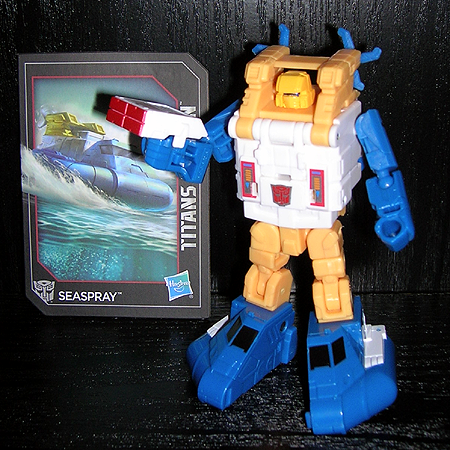
The updated Seaspray follows a design similar to his 1985 version, changing from a slightly tubby robot to a compact hovercraft. The current version has much more articulation, of course, and I like how his enormous feet could suit a clown, a water skiier, or a drowned mobster. I could see his many moving parts getting weak after a few dozen transformations, but then I’m no longer a ten-year-old kid who treats every toy like a stage from Wrecking Crew.
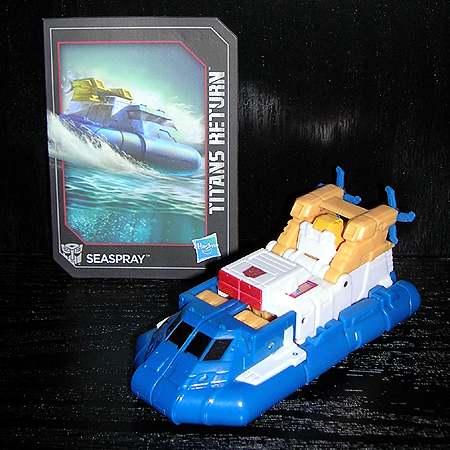
Seaspray also looks fine as a hovership, though I note one little shortcoming: his old ‘80s version had wheels on the bottom, and this new one does not. I know that most hovercraft don’t have wheels, but nor do most hovercraft turn into alien robots.
All things considered, it’s a good little toy.
Yet there’s another reason I bought it, and it’s the same reason that Seaspray is one of my favorite Transformers.
The 1980s Transformers cartoon was at its best when it got flat-out insane. It was, of course, crafted entirely to sell toys, but sometimes the mixture of mercenary writing and hasty production gave rise to memorably, wonderfully ridiculous episodes. My favorite such specimen is “Sea Change,” in which Seaspray finds true love with a woman of flesh and blood.
This episode sends Seaspray, Bumblebee, and a few other new Transformer toys to an alien world where the Decepticons have enslaved the elf-eared inhabitants. Our Autobot heroes quickly make allies among the rebels, and Seaspray takes a liking to one of them, a woman named Alana.
Before long, the natives reveal a secret weapon: a pool that changes them into mer-people while destroying non-organic life such as Decepticon drones.
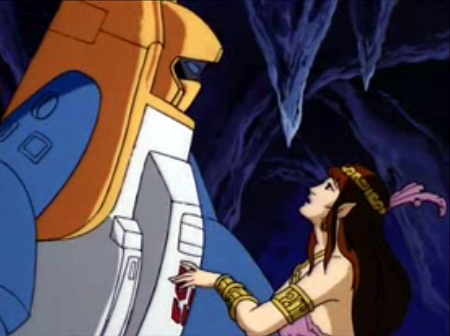
This magical sauna would apparently disintegrate Transformers, but Seaspray is convinced that he can withstand it. Undeterred by Alana’s warnings, Seaspray leaps into the pool and, by extension, tests whether or not he’s a mere robot. Yes, children, he’s risking his life to find out if he truly has a soul. Ponder that when you spend your allowance on a Seaspray figure, available at toy retailers and department stores across the nation.

Seaspray doesn’t just weather the transmogrification pool; he emerges as a hunky merman, much to Alana’s delight. And he didn’t even have to sell his voice to the sea-witch.
By the way, Seaspray goes through all of this with his gurgling water-voice intact. Alan Oppenheimer reportedly pulled off the sound by strumming his lips in front of the microphone, and here he had to do it for an entire episode. The man deserved an Emmy just for that.
The shapeshifting continues as Seaspray and Alana duck back through the enchanted mer-bath. Alana temporarily gives herself a robot form that leaves Seaspray stupefied as a Tex Avery wolf. They also trick Rumble, a mean little Decepticon punk, so that he falls in the mermaid stew and changes himself into a tree for most of the episode.
This tale of cross-species romance ends with the Decepticons stymied and retreating, even though the natives’ largest city is destroyed and the mermaid-making cavern with it. Seaspray and Alana realize that they’re from two different worlds and will remain so. The typical TV show would end this with a bittersweet parting and a return to the status quo.
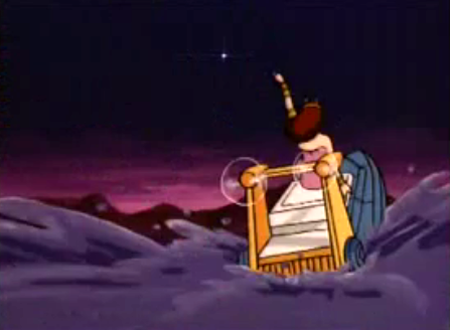
Well, that doesn’t happen. Seaspray and Alana declare their love for each other, and Seaspray emits a bizarre, jubilant gurgle that can’t be captured in onomatopoeia. They speed off together, having forged a romance beyond the bounds of logic and nature.
It’s very easy to mock or outright disdain these transparently commercial cartoons, and I might have done just that in a list for the now-shuttered and crumbling Topless Robot. Yet the truth is that I think “Sea Change” is utterly precious. Much of Transformers is silly when pulled back from childhood fascination, and this episode shoots far beyond that.
And why not? If you’re telling a story about giant robots that turn into Volkswagens and tape decks, why shouldn’t it be as ludicrous as possible?
It’s a nice change from the bleaker sectors of the Transformers world, which can get downright depressing for something engineered to push plastic at every Toys R Us of the 1980s. A bunch of outdated-toy characters died in Transformers: The Movie. Even more died in the comic books, which offed a few Autobots every issue once Simon Furman took over.
Beyond that, the stories seldom rewarded the Transformers. They’re robots in an unending war, and they don’t get to start families or explore relationships. They fight until they break or until their toys are no longer new. In that light, it’s heartwarming to think of Seaspray and Alana finding happiness together and raising a bunch of adopted mer-kids.
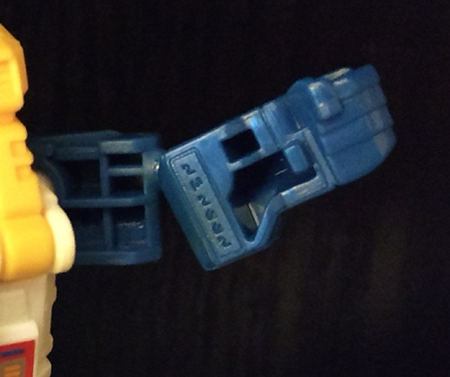
This brings us back to the new Seaspray toy. Look closely, and you’ll see a word engraved on both of his arms. It’s in squiggly Transformerese, but it translates to “Alana.” Aww.
And so I’d name “Sea Change” my favorite episode of any toy-backed animated show from the ‘80s. I have to, since it convinced me to buy something over twenty years after its airdate. There’s a lesson for any astute marketer: if you want to sell a product, make a cartoon where that product falls in love with an alien mermaid. You’ll have a loyal customer decades down the line.

No comments:
Post a Comment